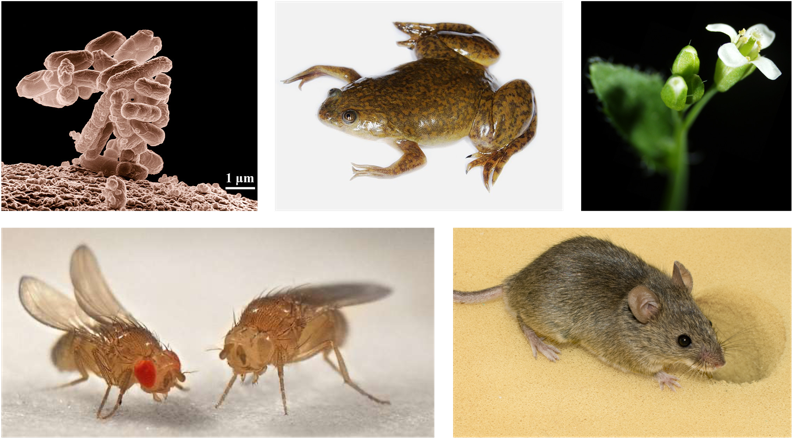Evolution and Ancestry
Learning Objectives
Objectives
- Recognize that evolution provides a framework for how geneticists view biology.
- Explain the role mutation and variation play in evolution
- Describe the processes by which evolution occurs, including genetic drift, gene flow, assortative mating, and natural selection.
- Explain how molecular genetics is used to deduce evolutionary relationships, recognizing that DNA sequence, protein sequence, and chromosome structure can all offer evolutionary clues
- Define: mutation, molecular clock, bottleneck, founder effect, assortative mating, haplotype, ortholog, paralog
Introduction
The evolutionary biologist Theodosius Dobzhansky said in 1973, “Nothing in biology makes sense except in light of evolution.”[1]This oft-quoted statement describes biologists’ understanding of the relationship among organisms on Earth. Evolution gives geneticists a lens for studying the mechanisms of inheritance. We see this in many of the fundamental concepts in this text:
- In the chapters on DNA structure and molecular genetics, we see that all organisms use the same biomolecules and the same genetic code. The mechanisms of molecular genetics – replication, transcription, translation, and control of gene expression – are likewise shared among all organisms. With the understanding that these processes are shared among all organisms because all organisms share a common ancestor, biologists can study these processes in one model organism and gain an understanding of how these properties work in all organisms. See Figure 1.
- In the chapter on Linkage, we discussed linkage disequilibrium and how parts of the genome are inherited as a unit, because there has not been enough evolutionary time to separate SNPs within a haplotype or because the area of the genome is under selection.
- In the chapter on Gene Expression in Eukaryotes, we looked at commonalities among the enhancers of genes important during development. Differences in an enhancer in snakes result in absent limbs, suggesting a mutation occurred in a snake ancestor after snakes diverged evolutionarily from other vertebrates. This is an example of how genetic variation can aid in our understanding of speciation, or the creation of new species over time.
- In the chapter on DNA Repair and Cancer, we see natural selection and microevolution on a cellular scale. Mutations in cancer cells give them a growth advantage over their healthy surrounding tissue, so the cancer cells overrun the tissue or organ. Duplication of the p53 tumor suppressor gene allowed the evolution of increased body size in elephants without a concomitant increase in the incidence of cancer.

Microevolution refers to measurable changes in population over time. These changes don’t create new species, but they can change the appearance or behavior of a population. We can often observe microevolution in action, either in the field or in the lab. We can also observe microevolution on a cellular level. The growth of a tumor, and its shrinkage following exposure to chemotherapy, are examples of microevolution on a cellular level.
Macroevolution refers to the accumulation of changes over a longer period of time. This includes significant enough changes to result in the creation of new species. Because macroevolution requires change over a long time, we typically cannot observe or measure macroevolution directly. Historically, macroevolution has been studied through comparison of homologous and analogous structures in different species, with dating dependent on the fossil record. In the case of human evolution, archaeological remains can offer clues as well. But in the last 20-30 years, the advent of molecular genetics and the genomic age have given us a way to study evolution on a molecular level.
In this chapter, we’ll look at the evidence for and mechanisms of evolution from a genetic perspective. We’ll look at examples of both microevolution and macroevolution, using humans and other organisms as examples.
Media Attributions:
Ecoli: By Photo byfkfkrErbe, digital colorization by Christopher Pooley, both of USDA, ARS, EMU. – This image was released by the Agricultural Research Service, the research agency of the United States Department of Agriculture, with the ID K11077-1 (next)., Public Domain, https://commons.wikimedia.org/w/index.php?curid=958857 Xenopus: By Brian Gratwicke – Flickr: Xenopus laevis, CC BY 2.0, https://commons.wikimedia.org/w/index.php?curid=23752908 Arabidopsis: By I, Suisetz, CC BY-SA 3.0, https://commons.wikimedia.org/w/index.php?curid=2448732 Mouse: By George Shuklin (talk) – Own work, CC BY-SA 1.0, https://commons.wikimedia.org/w/index.php?curid=5521043 Drosophila: By Fruit fly (Drosophila melanogaster), CC BY-SA 4.0, https://commons.wikimedia.org/w/index.php?curid=112257273
Media Attributions
- Model organisms is licensed under a CC BY (Attribution) license
- Dobzhansky, T. Nothing in Biology Makes Sense except in the Light of Evolution. Am. Biol. Teach. 35, 125–129 (1973). ↵

